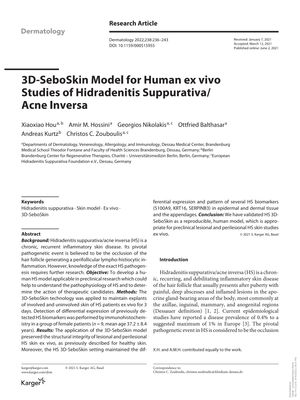TLDR Scientists created a 3D skin model to study a chronic skin disease and test treatments.
The document describes the development of a human ex vivo model for Hidradenitis suppurativa/acne inversa (HS), a chronic inflammatory skin disease, using 3D-SeboSkin technology. This model was used to maintain skin explants from HS patients for 3 days, allowing for the study of the disease's pathophysiology and the testing of therapeutic candidates. The study involved a group of 9 female patients with a mean age of 37.2 ± 8.4 years. The model successfully preserved the structural integrity of lesional and perilesional HS skin and maintained the differential expression of several HS biomarkers (S100A9, KRT16, SERPINB3) in the skin tissues. The HS 3D-SeboSkin model was validated as a reproducible tool for preclinical studies of HS skin ex vivo.
51 citations
,
March 2019 in “Experimental Dermatology” Matrix changes and increased MMPs contribute to skin inflammation in hidradenitis suppurativa.
284 citations
,
May 2002 in “Proceedings of the National Academy of Sciences” CRH promotes fat production in skin cells, affecting conditions like acne.
 September 2019 in “Journal of Investigative Dermatology”
September 2019 in “Journal of Investigative Dermatology” The 3D-SeboSkin model effectively simulates Hidradenitis suppurativa and is useful for future research.
 September 2019 in “Journal of Investigative Dermatology”
September 2019 in “Journal of Investigative Dermatology” Dermal Papilla Cells grown in 3D and with stem cells better mimic natural hair growth conditions than cells grown in 2D.
52 citations
,
January 2017 in “Dermatology” Swiss experts recommend specific guidelines for diagnosing and treating hidradenitis suppurativa to improve patient care.

Hidradenitis Suppurativa has genetic links, with certain gene mutations more common in patients and a third of cases having a family history.
 25 citations
,
December 2018 in “Human Molecular Genetics”
25 citations
,
December 2018 in “Human Molecular Genetics” The document concludes that certain mutations may contribute to the inflammation in hidradenitis suppurativa and suggests that targeting TNFα could be a treatment strategy.




